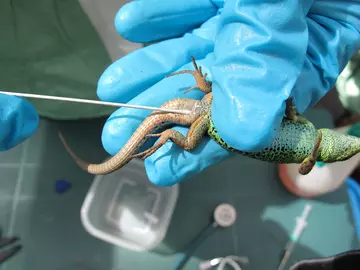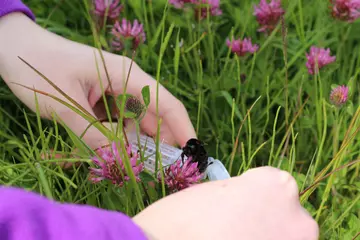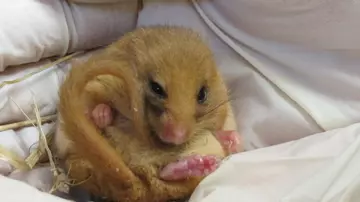
Dr Sophie Common
Wildlife Veterinarian | Research Associate
Wildlife vet Sophie Common discusses the importance of protecting British wildlife, and how the DRAHS team at ZSL are working towards this.
This Sunday, millions will tune in to Wild Isles, the latest BBC Attenborough documentary. As nature lovers, everyone at ZSL always looks forward to Attenborough’s work – not least because our close relationship with Sir David stretches back to the very beginning of his career.
ZSL has contributed to many of his previous award-winning BBC series, providing much-needed behind-the-scenes wildlife expertise in the planning stages of the extensive production it takes to bring these programmes to life.
But this series is one we’re particularly invested in, as it promises to be a celebration of the UK’s native species - which ZSL has long worked to protect and restore through its world-leading science and conservation.
From our inner woodlands to our outer coastlines, we’re protecting threatened native species such as the Critically Endangered angelshark, harbour seals, Fen raft spider, native oyster, hazel dormouse and more, while restoring vital ecosystems such as kelp forests and working with industries and local communities to inspire change where it is most needed.
And all of ZSL’s conservation work is led by the latest science, developed at ZSL’s Institute of Zoology.
So how do we protect the health of our native species? Let’s take a deep dive into just one branch of ZSL’s native species work.

Protecting the Health of our Native Species
Often, when we think of wildlife and conservation, we imagine tropical rainforests, vast savannahs, or distant coral reefs. It is easy to forget that we have a plethora of unique, charismatic and, in some cases, threatened, species right on our doorstep for which conservation efforts are much needed.
From hazel dormice to white-tailed sea eagles, sand lizards to chequered skipper butterflies, red kites to beavers, and pool frogs to Eurasian curlew, the Disease Risk Analysis and Health Surveillance (DRAHS) team at ZSL’s Institute of Zoology work with a vast array of experts and organisations to protect and restore British wildlife.
How are ZSL working to protect British wildlife?
The DRAHS team is made up of five wildlife veterinarians, one research assistant and one pathology and field technician, all working towards the goal of helping wildlife thrive in the UK through conservation techniques including translocations and reintroductions.
Specifically, we analyse and reduce the risks from disease to our native wildlife through a combination of research, health checks, disease-prevention protocol development and pathological examinations or post-mortems, which help us discover the threats our native species are facing in the wild.
Sadly, much of Britain’s wildlife is under serious threat - but there is hope. Species that were once lost are now being restored to their wild British homes thanks to decades of work from conservationists and scientists. We monitor the health of species throughout the reintroduction process, before, during and after, working alongside Natural England as longstanding partners in their Species Recovery Programme for native British species.

Why is DRAHS so important?
Diseases pose a tangible threat to conservation efforts for all species, including native British wildlife. In particular, wild animal translocations - moving animals from one place to another, for example to bolster an existing population or to reintroduce them to a new site - provide several opportunities for disease risks to arise. When an animal is moved from one place to another, a ‘biological package’ of all the viruses, bacteria and parasites carried by the animal comes with it. If appropriate precautions are not taken throughout the translocation process, the possibility of releasing a non-native parasite into the wild can arise.
This has led to devastating consequences in the past. For example, the amphibian fungal parasite Batrachochytrium dendrobatidis, or ‘chytrid fungus’ as it is often called, is associated with the population declines of more than 500 amphibian species and is the presumed cause of almost 100 extinctions across the globe. The introduction of this fungus to new ecosystems and hosts was facilitated by the global movement of amphibians for the pet trade, food industry and, in some cases, for conservation purposes, highlighting just how important it is that effective protocols are put in place when planning wild animal translocations. Global amphibian movements have also driven the emergence of ranaviral disease, which has led to mass mortality events in several amphibian species and population declines in common frogs in England.
Moving away from amphibians, crayfish plague, caused by a water mould, has contributed to the extinction of the native, white-clawed crayfish in many waterways in Southern England; infection is amplified by the presence of the invasive, non-native American signal crayfish, which acts as a reservoir for disease. Elsewhere, squirrelpox virus decimated populations of native red squirrels after it hitched a ride with non-native grey squirrels, introduced into Great Britain in the 19th century.

Safeguarding translocated animal health
Moving animals between sites can be an essential part of conservation efforts to protect vulnerable species, but careful planning to safeguard their health is essential; these individuals are precious, and often members of very small populations, sometimes carefully reared by conservation zoos including ZSL’s London and Whipsnade.
DRAHS has worked directly with the recovery programmes of over 30 UK species to ensure the success of every translocation project – through protecting these ecologically valuable animals, as well as existing wildlife populations and ecosystem, from the devastating impacts of disease. We also work to protect animals throughout the translocation process itself, to ensure they remain calm and comfortable. Stress reduction is imperative - a reduction in immunity (such as occurs when an animal is stressed) can cause a usually ‘harmless’ microorganism to lead to disease, threatening the health and wellbeing of these important individuals.
Some of the species the DRAHS team are currently working with will have a much-needed spotlight thrown on them in the Wild Isles series, including white-tailed eagles and hen harriers.
We’re looking forward to tuning in as much as everyone else!
Find out more about ZSL’s DRAHS work
Climate change and human activity have pushed our precious planet to its limit, causing the devastating loss of so many habitats and species. From lab to field, hands on and behind the scenes, we’re leading the future of conservation, shaping agendas and influencing change to support better life, health and living for people and wildlife.
